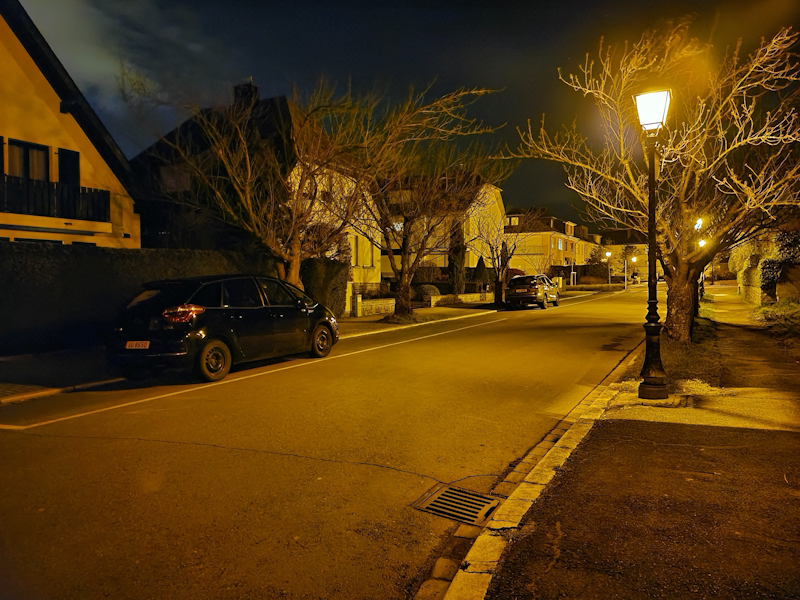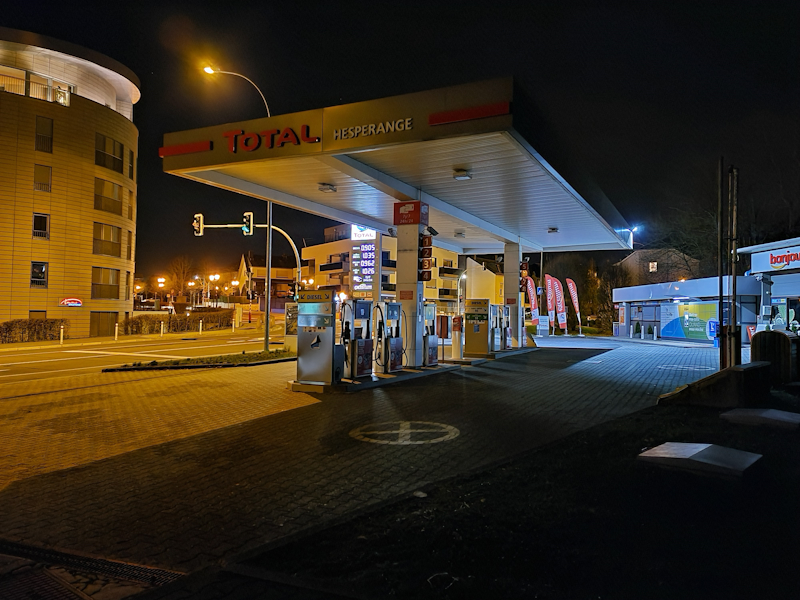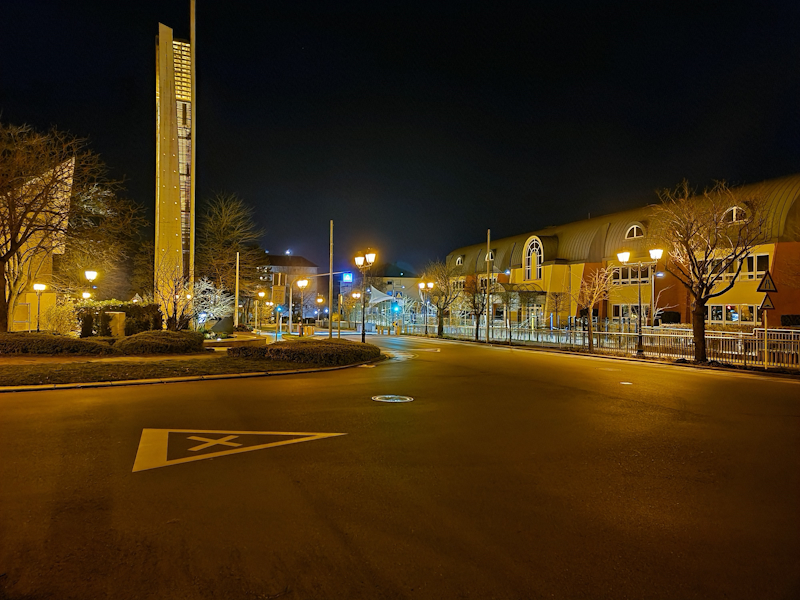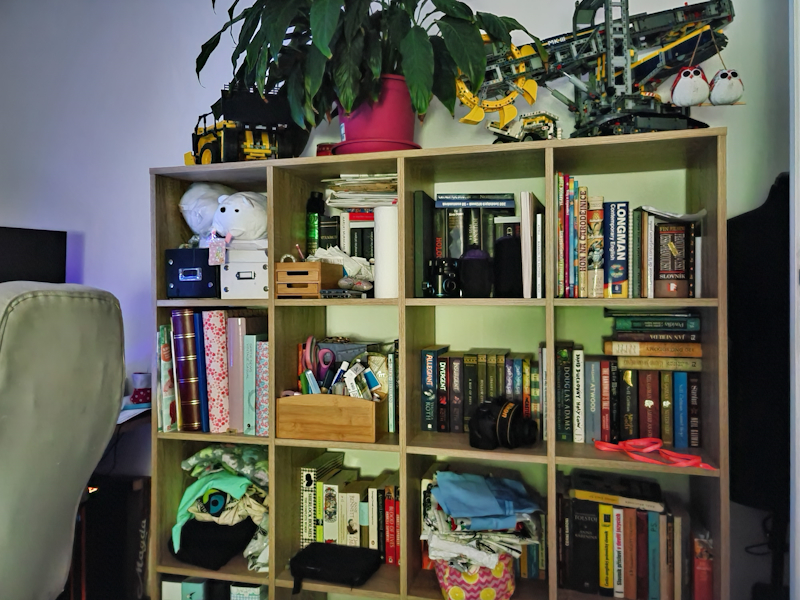The Samsung Galaxy S20+, S20 Ultra Exynos & Snapdragon Review: Megalomania Devices
by Andrei Frumusanu on April 3, 2020 9:30 AM ESTCamera: Low Light Evaluation
While daylight pictures maybe aren’t that large of an upgrade for the S20 series, the new huge sensors must showcase some notable improvements in low-light scenarios, virtue of their much improve low-light capturing abilities.
Things get a bit more complex here as not only we have to deal with the default output of the cameras, but also take into account computational photography modes such as the various new Night Modes that have by now been normalized by essentially every smartphone vendor.

[ Galaxy S20U - (S) ]
[ Galaxy S20U - (E) ]
[ Galaxy S20+ (E) ]
[ Galaxy S10+ (S) ]
[ Galaxy S10+ (E) ]
[ iPhone 11 Pro ] - [ Pixel 4 ]
[ Mate 30 Pro ]
[ P30 Pro ] - [ X-T30 ]
Starting with the S20 Ultra’s telephoto modules, it’s essentially useless in low-light without Night mode as the narrow aperture optics just aren’t able to catch any meaningful amount of light. Switching over to Night mode makes them useable, however with very different results on the Snapdragon and Exynos. The Exynos is extremely red and it’s showing some heavy ISO artifacting on the building, while the Snapdragon is just way blurrier, as if the image was actually captured with the main camera sensor and not the telephoto module. Both results just aren’t good, but that was somewhat to be expected at low-light.
On the main sensors, both units do respectably well and have much better dynamic range than other smaller cameras, with the exception of Huawei. Turning on night mode improves things a ton, but there are differences between the Snapdragon and Exynos phones; the Qualcomm phone is significantly sharper and its night mode processing is able to retain a whole ton more detail throughout the scene.
The problem is that they’re both worse than what the S10+ variants were able to achieve, which is probably not what you’d want to see from a newer generation phone with much improved camera hardware.
The S20+’s shot is almost identical to the S20 Ultra’s (between Exynos versions) and the camera sensor’s superiority on the S20 Ultra is only used to reduce the ISO from 2000 to 1600.
The Huawei Mate 30 Pro here just outright destroys the S20’s in low-light, and that’s not even the best the company has to showcase as the newer P40 Pro comes with an even more capable sensor.
The Ultra-Wide however does see some evident upgrades as it’s clearly an upgrade in quality compared to what the S10 series were able to offer. Given that Huawei’s Ultra-Wide angle isn’t nearly as wide, the S20 series are actually the best performing phones now in this camera module category.

[ Galaxy S20U - (S) ]
[ Galaxy S20U - (E) ]
[ Galaxy S20+ (E) ]
[ Galaxy S10+ (S) ]
[ Galaxy S10+ (E) ]
[ iPhone 11 Pro ] - [ Pixel 4 ]
[ Mate 30 Pro ]
[ P30 Pro ] - [ X-T30 ]
Night mode however doesn’t always favour the Snapdragon. In this case it’s the Exynos model which is far ahead in the resulting image processing, being far sharper and more detailed than the other S20 Ultra. While the Snapdragon S20 Ultra has issues differentiating itself against the S10+s, the Exynos S20 Ultra and S20 produce excellent images that are a large generational leap in quality. They even manage to trade blows and beat the Mate 30 Pro here.
Take note of the picture quality differences between the S20 Ultra’s 2x zoom and what the S20+ is able to achieve here. The latter is essentially able to take advantage of double the resolution and thanks to the sensor fusion produces a result that leaps and bounds ahead of the S20 Ultra.

[ Galaxy S20U - (S) ]
[ Galaxy S20U - (E) ]
[ Galaxy S20+ (E) ]
[ Galaxy S10+ (S) ]
[ Galaxy S10+ (E) ]
[ 11 Pro ] - [ P4 ]
[ Mate 30 Pro ]
[ P30 Pro ] - [ X-T30 ]
When there’s a little more light available, the S20 Ultra’s telephoto module becomes more usable even in low-light, and actually manages some good, or better say, passable results, at least it’s way better than any other phone in this zoom range. What this shot also exposes is some odd vertical lens flaring that’s present on both S20 Ultras. The lenses were completely clean, so this must be results of internal reflections and optics of the module itself, particularly because they’re almost identical between the two phones.
In this scene it’s also the Exynos S20 Ultra which takes the lead in terms of the processing – both in Night mode and in the default auto mode. The Snapdragon just blurs out details and textures a lot more.
Comparing the regular shots of the S20U-E against the S20+E, we can actually better see the hardware differences between the two phones, as the Ultra really is able to resolve more detail throughout the scene. The S20+ also is a huge upgrade against the S10 series here, only falling short to the Mate 30 Pro.

[ Galaxy S20U - (S) ]
[ Galaxy S20U - (E) ]
[ Galaxy S20+ (E) ]
[ Galaxy S10+ (S) ]
[ Galaxy S10+ (E) ]
[ iPhone 11 Pro ] - [ Pixel 4 ]
[ Mate 30 Pro ]
[ P30 Pro ] - [ X-T30 ]
One commonality I found during the shooting with the S20’s is that the darker it gets, the more inconsistent they get. In this playground shot which was extremely dark, the S20+ actually produces a better result than the S20 Ultra. Between the two Ultras, I feel like the Exynos had the edge again, but the Snapdragon this time around handles the noise better. The problem is that they’re not representing satisfactory upgrades compared to the S10 shots, in particular the latest Android 10 firmware update on the Snapdragon S10+ has seemingly improved things a lot. Then you open up the Mate 30 Pro sample and realize that neither of the new Samsung phones is actually able to come even near the picture quality that Huawei is showcasing, and even falling behind Apple here in regards to Night Mode quality.

[ Galaxy S20U - (S) ] - [ Galaxy S20U - (E) ]
[ Galaxy S20+ (E) ]
[ Galaxy S10+ (S) [ Galaxy S10+ (E) ]
[ iPhone 11 Pro ] - [ Pixel 4 ]
[ Mate 30 Pro ] - [ P30 Pro ] - [ X-T30 ]
Finally in this last scene, things are again quite disappointing. Between all the Samsung phones, old and new, it’s the Exynos S10+ which had by far the best results in Night Mode, and even the Snapdragon S10+ beats all the new S20s in terms of detail of the scene. The new phones are beaten not only by their predecessors, but also Apple and particularly Huawei.
Overall Low-Light Conclusion
Overall, I think the S20’s software processing in low-light is quite a mess. We saw some scenes where the new S20 phones are clearly better than other phones, but this seemingly only happens in medium-light conditions, as the darker you get, the worse the results. There’s also some quite large differences in the software processing between the Snapdragon and Exynos phones this year, this time around it’s the Exynos model which is very clearly better in the majority of scenarios as the Snapdragon variant very often blurs out details and textures.
The problem is that they are all just disappointing and none of the new phones actually live up to their hardware capabilities. Huawei is very much beats even the new S20 Ultras with ease, and sometimes the processing falls so flat that currently even the S10 phones do better in some scenarios.
I understand that cameras are usually the last aspects of a phone that get attention during development, but this is quite the ridiculous situation where things keeping in such a unrefined state early in a device’s release cycle. I’m 100% certain Samsung will be issuing a ton of firmware upgrades over the coming months and likely to improve things, but the media cycle and reviews are coming out now and that’s what most users will see when they’re reading about the S20 series. It’s just an unfortunate situation.










137 Comments
View All Comments
Shadowfax_25 - Friday, April 3, 2020 - link
Excellent article, Andrei. The team over at XDA Developers managed to identify the adb commands which would allow you to set the display to either of the other refresh rates, so I'm sure Samsung could in some way introduce variable refresh rate switching.Here's the article for your perusal: https://www.xda-developers.com/samsung-galaxy-s20-...
Andrei Frumusanu - Friday, April 3, 2020 - link
Yea I saw that. In an ideal case Samsung would actually implement their own pseudo-VRR mode that switches between the display refresh rates based on content.Shadowfax_25 - Friday, April 3, 2020 - link
One more thing: it appears as if the commentary around the speaker evaluation is missing.Shadowfax_25 - Friday, April 3, 2020 - link
Ignore, looks like it was a caching issue on my side.eastcoast_pete - Friday, April 3, 2020 - link
Yes, but that would make sense, and this is Samsung we're talking about here. Still, there's hope, I guess.CecilFitzgerald - Monday, October 12, 2020 - link
Machine learning is in great need now. During the coronavirus period, it would be nice to identify some dependencies and foresee what will happen next in the world. By the way, if you also need to write an essay on machine learning, then i advise you to turn to https://buypapercheap.net/affordable-term-papers-f... which offers writing term papers at affordable prices.yeeeeman - Friday, April 3, 2020 - link
Andrei, amazing review TBH. You have outdone yourself once again and, fie vorba intre noi, cred ca esti succesorul cel mai potrivit pentru Anand. Esti cel mai profi si cand vine vorba de detalii tehnice, dar si de idei interesante de comparatie intre diferite device-uri. Am scris in romana sa nu se supere colegii tai.Please try to add to the energy efficiency table, Ice Lake scores and maybe some energy usages like you have for mobile devices? That would be amazing!
Unashamed_unoriginal_username_x86 - Friday, April 3, 2020 - link
avem traducere Google, tipuleyeeeeman - Friday, April 3, 2020 - link
Tipule, era o glumita. Logic ca poti folosi traducerea.abufrejoval - Saturday, April 4, 2020 - link
Born German with Latin as my first foreign language, and with fluent Spanish and French picked up later, written down Romanian isn't nearly as hard to understand as the spoken language... bine, bine!